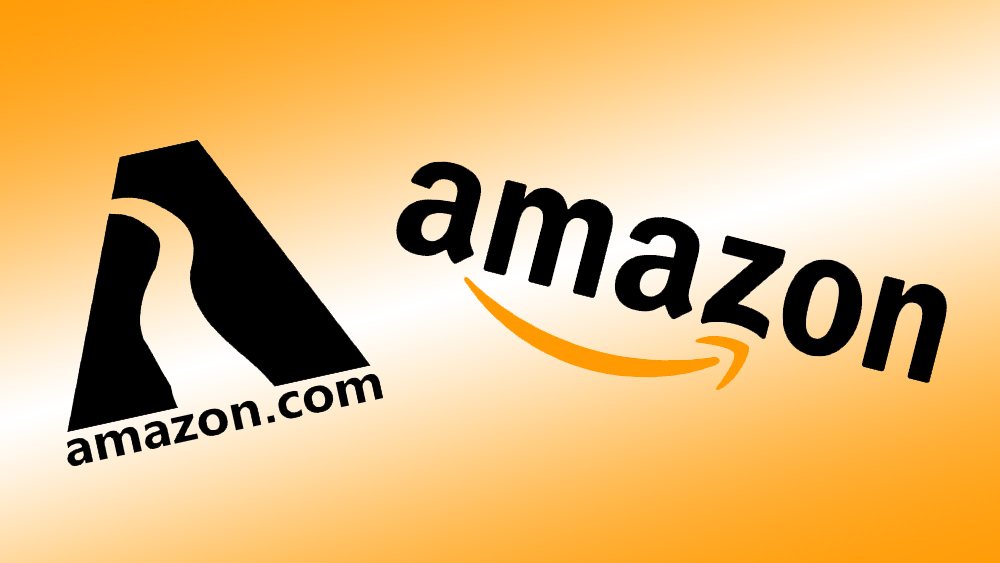
In the cutthroat world of retail, one curved line has changed everything. Amazon's logo, now as ubiquitous as the cardboard boxes piling up on doorsteps worldwide, tells a story of ambition, growth, and marketing genius. When Jeff Bezos launched "Earth's Biggest Bookstore" in 1994, few could have predicted that a simple online bookseller would revolutionise shopping as we know it.
Amazon is now 30 years old, and to track its progress from bookseller to retail giant, here, we take a look at how its logo has grown and evolved over three decades. For more on logos, see our best logos list or series on logo histories and for how the retailer can help you save money, see our Apple Amazon Prime Day deals page.
01. Amazon's original logo (1995-1997)

Amazon first opened its virtual doors with a very functional logo that was a far cry from the sleek, ubiquitous design we know today. The initial emblem, crafted by agency Turner Duckworth (who would go on to craft today's Amazon logo), featured a stylised 'A' logo mark with a winding river above a simple sans serif wordmark.
This design represents Bezos' goal to create the world's largest store, echoing the Amazon's status as the world's largest river and forest. The river imagery also suggested flow and connectivity, aligning with Bezos' vision of a vast, global marketplace.
Amazon's first brand refresh (1997-1998)

In 1997, Amazon briefly adopted a logo reminiscent of the excesses in late '90s design trends. The new look featured a similar shape to the original logo, except for an over the top pattern that negates its visual impact, especially in a digital context.
Opinions are divided on if the design represents zebra stripes, branches in a forest, contour lines on topographical maps or river tributaries. But whatever the intent, instead of elevating Amazon's brand identity, it created a confusing visual experience that left viewers puzzled rather than impressed.
The distracting design lasted hardly a year before being replaced, serving as a cautionary tale about the importance of focused, purposeful logo design.
Trial and error, a year of evolution (1998)

1998 marked a pivotal year in Amazon's evolving brand journey, with the company testing out three distinctly different logos as it grappled with its identity as a rapidly expanding business. While none of these designs struck gold, each contributed valuable elements to what would ultimately become Amazon’s iconic visual identity.
The first 1998 attempt abandoned the bold 'A' for a simple Times New Roman wordmark 'amazon.com', accompanied by the ambitious tagline 'Earth's Biggest Bookstore'. Though underwhelming visually and lacking colour, it signalled Amazon's desire to move away from an association with the South American river, and stake claim to its core value proposition and differentiator. Placing the tagline front and centre in the logo clearly communicated what Amazon was to mainstream consumers at a time when the brand soared to success.

Next came a stripped-down sans serif version of the wordmark that introduced the now-familiar yellow-orange hue into the mix. While still missing the mark, this brand colour would prove enduring. This version also experimented with capitalisation, presenting the name as 'AMAZON.COM'. Notably, it included an oversized 'O', possibly representing the company's global expansion and success.

The final 1998 iteration, which survived until 2000, was the basis for the company’s current logo design. It featured a bold, near-sans-serif font and an orange underline that was a precursor to the ‘smile’ we know today. This rapid branding iteration reflects Amazon's explosive growth and its struggle to capture its evolving identity visually. Though each logo had flaws, they collectively laid the groundwork for the iconic design that would emerge in the new millennium.
The iconic smile logo (2000-present)

As the millennium approached, Amazon's aspirations grew beyond books - and it turned back to its original agency Turner Duckworth to evolve its now ubiquitous logo design to its final state.
The new logo retained the streamlined typography of its immediate predecessor, opting for a clean, lowercase font that exudes approachability. Gone was the '.com', reflecting Amazon's confidence as an established brand, no longer needing to emphasise its online nature as one of the notable survivors of the dot-com bubble.
The real innovation, however, lay in the transformation of the underline. The straight orange streak evolved into a curved arrow, connecting the 'a' to the 'z'. The curve also evokes a subtle smile, indicating customer satisfaction – a central tenet of Amazon’s brand. This simple yet brilliant touch conveys the company's extensive A-to-Z product range, customer-centric approach, and sense of forward momentum. While clearly a visual departure from the original river-like imagery in the logo, it is significant that a core logo element has remained a central curved line, creating a subtle continuity that represents the growth and history of the company’s visual identity.
With its various iterations, Amazon's logo journey showcases how many big companies’ visual brands evolve alongside their growth, highlighting the crucial role of experimentation in developing a truly impactful logo and visual identity. From the representation of its namesake river to the subtle smile that now graces millions of packages, Amazon's logo journey reflects its transformation from a plucky online bookstore to a global e-commerce empire.
Want more logo histories? See our analysis of the Apple logo history and Starbucks logo history.







